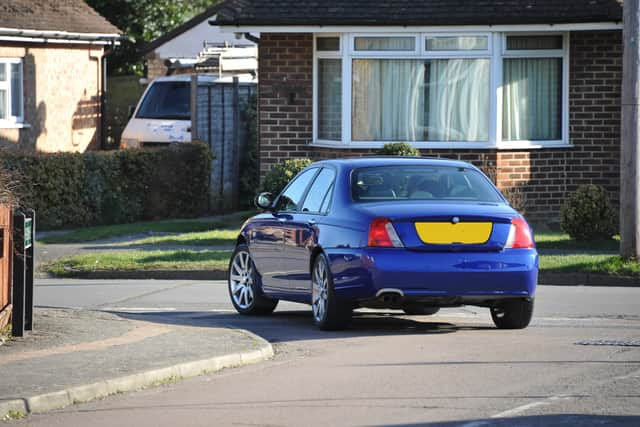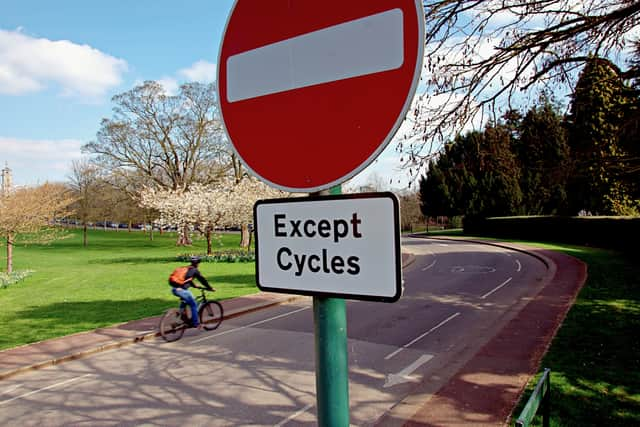The 10 most common driving test fails: how to avoid most regular mistakes and how many faults you are allowed
and live on Freeview channel 276
Learner drivers are facing a tough time at the moment with long waits to secure a test and rising costs associated with learning.
Waiting lists of up to 24 weeks for a practical test appointment and new rules that force learners to wait longer to resit if they fail are piling pressure on candidates to pass first time. But figures from the DVSA show that after a post-pandemic jump, pass rates have been falling again.
Advertisement
Hide AdAdvertisement
Hide AdData from January to March 2022 shows that the pass rate fell to 47.1%, a decline from 48.1% in the previous quarter and well down on the 49.8% in 2020/21. While the pass rates vary, the DVSA figures show that it is the same mistakes that catch learners out year after year.
Learner drivers aren’t expected to be perfect and are allowed to make a number of small mistakes but too many, or a major error and you’ll fail. Under current rules, you can make up to 15 minor faults (known as driving faults) and still pass. However, making the same fault too many times could become a serious fault, which is an automatic fail. Anything that causes actual danger to you, the examiner, the public or property is classed as a dangerous fault and is, unsurprisingly, an instant fail.
With all that in mind, here is the DVSA’s list of the most common reasons learners fail their test along with some tips from the CEO of RED Driver Training, Seb Goldin, on how to avoid them.
1. Not making effective observations at junctions
This covers a wide number of individual errors - from failing to check properly when stopped to failing to notice a crossroads. According to the DVSA you must make effective observations before moving into a new road and make sure it is safe before proceeding. Failure to do so will result in a fault. The category covers mistakes including looking too late or “making no effective observations at all”, failing to judge the speed of an approaching vehicle and entering a roundabout in front of a vehicle approaching from the right.
Advertisement
Hide AdAdvertisement
Hide AdSeb advises: “At junctions, time for planning and judgement is vital, and it should be clear that you’re taking this into account in your test by closely monitoring what is happening around you, and using cues in these surroundings to help you inform how to approach any upcoming scenarios. For example, this could include taking adequate time to slow down before any junctions or traffic lights ahead. Observation will be classed as poor if you approach a junction too quickly, don’t take enough time to observe the obstacles around you or fail to notice pedestrians or cyclists.”


2. Not using mirrors correctly when changing direction
The importance of using your mirrors is one of the first things every learner is taught but failing to use mirrors properly is still the second most common mistake driving test candidates make. Failing to check before pulling into another lane, or not checking mirrors on a roundabout will not go down well with the examiner.
Seb says: “It is vital to remember that the appropriate mirrors must be checked before turning and not during or after.Remember to mirror, signal, manoeuvre.You should only signal to move and do so when you are certain it is safe, after checking all mirrors thoroughly. You will receive a fault if you forget to check your mirrors before changing direction or if you check your mirrors whilst changing direction.”
3. Not having proper control of the steering
Being in control of the car is a fundamental part of driving but a lack of proper control is still the third most common reason learners fail. The DVSA’s guidance emphasises the need to steer smoothly and at the correct time but its data highlights learners repeatedly making mistakes such as steering too early or late for a corner or junction and even mounting the pavement when pulling up.
4. Incorrect positioning when turning right at junctions
Advertisement
Hide AdAdvertisement
Hide AdRoad positioning is important to carry out manoeuvres safely and to let other drivers know your intentions. This fault covers drivers using the wrong lane at roundabouts, sitting too far to the left when trying to turn and obstructing other traffic while waiting to turn.
5. Not moving off safely
During a driving test learners have to stop and pull away in a number of scenarios, including moving off from the side of the road, on a slope or hill, from behind a parked vehicle, and from an emergency stop. As well as the technical aspect of pulling away smoothly, examiners are checking that you make the correct observations and don’t cause problems for other drivers.
Seb warns: “Instances which wouldn’t be deemed safely moving off could include not checking for blind spots or moving off from behind a parked vehicle into the path of an approaching vehicle.”
6. Not responding appropriately to traffic lights
Once you’ve got your licence failing to react to traffic lights can land you a fine and penalty points but doing so on your test is grounds for failure. This fault not only covers failing to stop for red lights but also crossing the stop line at a junction, not proceeding when there is a green light or proceeding when the light is green but the junction isn’t clear.
Advertisement
Hide AdAdvertisement
Hide AdAccording to Seb, observation and anticipation are key to avoiding this mistake. He says “Unsurprisingly, and in line with general traffic light guidance, it is only okay to continue past a white ‘stop’ line (a solid white line, wider than other road markings) if the light is green. Once the amber light appears, a driver should stop at the line and not proceed, unless stopping suddenly would cause a collision. The best advice is, as a driver approaches a green light, they should keep checking their mirror and anticipate that it is likely to change, and therefore be ready to stop. Drivers should only ever proceed if the road ahead is clear.”
7. Poor positioning on the road during normal driving
On a driving test you should always position the car correctly for your intended route, in the middle of marked lanes and should only change lanes when necessary. However, some candidates struggle with this, repeatedly sitting too close to either the kerb or the oncoming traffic, ignoring the normal road position on roundabouts or unnecessarily driving in the right-hand lane of a dual carriageway.
8. Not responding correctly to traffic signs


Before sitting their test learners are expected to study the Highway Code and be clued up on the meaning of road signs but test time still sees many caught out and failing to follow signs correctly. This can range from ignoring a stop or give way sign to using an active bus lane or ignoring a change in speed limit.
“Understanding road signs is an integral part of the theory test,” says Seb. “Now you must put this into practice for the practical test, reacting appropriately to all traffic and road signs. Common mistakes include going to the wrong side of a ‘keep left sign’ and ignoring a ‘stop’ or ‘no entry’ sign. Post theory test, motorists should continue to refresh their memory of road signs through self-testing – even when travelling as a passenger.
9. Not having control of the vehicle when moving off
Advertisement
Hide AdAdvertisement
Hide AdStalling a car once or twice during your driving test won’t lead to a failure but repeatedly stalling, either in the same moving off attempt or repeatedly throughout the test could lead to a fail mark and falls into this category. Other issues that crop up in this group of errors include rolling back on a hill start or trying to move off without selecting a gear, causing the car to roll back.
10. Not keeping control of the vehicle during reverse parking
This is a more specific issue than some of the others on this list yet it’s a common enough problem to make it into the top 10 reasons for failure. Issues can include ending up on the pavement or outside the lines of a parking bay, taking too many attempts to reposition or losing control during the manoeuvre.
Comment Guidelines
National World encourages reader discussion on our stories. User feedback, insights and back-and-forth exchanges add a rich layer of context to reporting. Please review our Community Guidelines before commenting.
